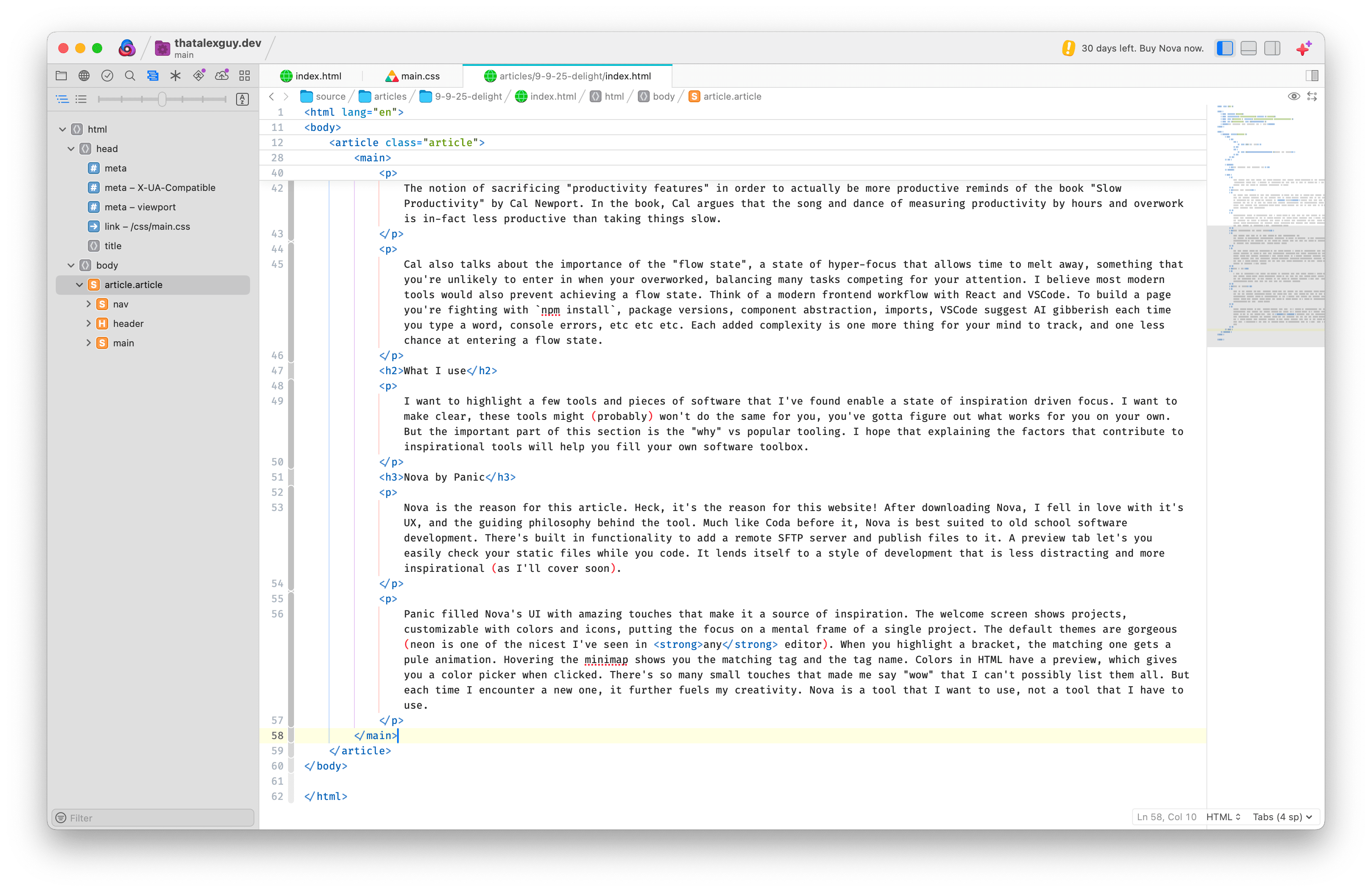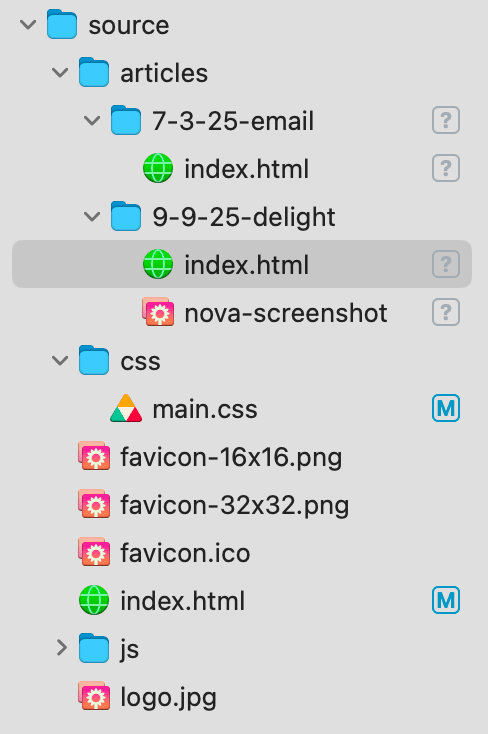Use software that delights you
I've always been into tech, and until recently that meant switching to the newest, latest thing. Development frameworks, languages, IDEs, etc. I figured if something new came out, it must be better and I had to jump on it (or suffer the consequences of being left behind). But as I've unfortunately come to learn, most new stuff is garbage, especially in tech.
Using what works
One thing I've learned is that it's important to fight the urge to follow that crowd, even when it comes to computing. If you tell the average engineer you use Sublime Text in 2025, they'll probably look at you like you're crazy (or ask what the hell is Sublime). But the thing is, Sublime is still faster than most text editors, and isn't loaded with AI garbage. The key is to find the tools that balance productivity and satisfaction. While something like PHPStorm or VSCode might have fancier auto complete, these tools don't satisfy me, and in turn lead to me being less productive, despite all the extra features they introduce.
Satisfaction lends to creativity. It's a weird thing to say, that the text editor or the CSS processor you use can lead to one being more creative, but for me that's exactly the case. Using software that I enjoy and that brings satisfaction inspires me. For example, any piece of software from Panic is filled with inspiring UX, rock solid functionality and performance that only native first applications can achieve. Using something Panic's Nova editor inspires me to build and be creative, because the tool itself is something I draw inspiration from.
Slow productivity and flow states
The notion of sacrificing "productivity features" in order to be more productive reminds of the book "Slow Productivity" by Cal Newport. In the book, Cal argues that the song and dance of measuring productivity by hours and overwork is in-fact less productive than taking things slow.
Cal also talks about the importance of the "flow state", a state of mental hyper-focus that allows time to melt away, something that you're unlikely to enter when your overworked and balancing many tasks competing for your attention. I believe most modern tools would also prevent achieving a flow state. Think of a modern frontend workflow with React and VSCode. To build a page you're fighting with `npm install`, package versions, component abstraction, imports, VSCode suggesting AI gibberish each time you type a word, console errors, etc etc etc. Each added complexity is one more thing for your mind to track, and one less chance at entering a flow state.
What I use
I want to highlight a few tools and pieces of software that I've found enable a state of inspiration driven focus. I wish to make it clear, these tools might (probably) won't do the same for you, you've gotta figure out what works for you on your own. But the important part of this section is the "why" these work for me vs popular tooling. I hope that explaining the factors that contribute to inspirational tools will help you fill your own software toolbox.
Nova by Panic
Nova is the reason for this article. Heck, it's the reason for this website! After downloading Nova, I fell in love with it's UX, and the guiding philosophy behind the tool. Much like Coda before it, Nova is best suited to old school software development. There's built in functionality to add a remote SFTP server and publish files to it. A preview tab let's you easily check your static files while you code. It lends itself to a style of development that is less distracting and more inspirational (as I'll cover soon).

Panic filled Nova's UI with amazing touches that make it a source of inspiration. The welcome screen shows projects, customizable with colors and icons, putting the mental focus on a single project. The default themes are gorgeous (neon is one of the nicest I've seen in any editor). When you highlight a bracket, the matching one gets a pulse animation. Hovering the minimap shows you the matching tag and tag name. Colors in HTML have a preview, which gives way to a color picker when clicked. There's a menu item called "Zap Gremlins..." that removes nasty hidden characters. There's so many small touches that made me say "wow" that I can't possibly list them all. But each time I encounter a new one, it further fuels my creativity. Nova is a tool that I want to use, not a tool that I have to use.
HTML, CSS, Tailwind, Plain JavaScript
My last iteration of this website ran on Hugo. I had installed the Blowfish theme and customized a number of the partials. Content was driven by Markdown that compiled into static HTML. I had a Github Actions pipeline that would build and deploy the site. To hack on the site, I needed to install Go and the Hugo tooling. ....That's a ton of things to keep in my mind just to publish an article online. I had based this stack around the thoughts of "I want this to be easy", "what if I need to scale it out", "this is what a modern site should look like". Because of the complexity (even though it's not that complex compared to a lot of modern sites), working on the site wasn't interesting, or inspiring. So I stopped, again (I've had more blogs than I can count).

Inspired by the workflow that Nova lends itself too, I switched to HTML and CSS. Admittedly I did keep one tool from the modern world, TailwindCSS, and I'll explain why in a sec. Now my site runs on any old Apache/nginx server. It's easy to deploy, and easy to work on. The site loads fast and works on any browser/computer/device. Most importantly, there's less context switching. I've been working with HTML and CSS for so long that I've memorized basically everything I need to know. I don't need to look things up, and syntax doesn't change with updates. This lets me focus on what I'm building without distraction. This is also why I use Tailwind, the syntax is embedded in my brain, which allows me to style things extremely quickly. For people that have never used Tailwind, it would probably have the opposite effect, leading to looking up syntax frequently and breaking any hope of flow.
CodeKit by Bryan
I've been using CodeKit for nearly 8 years, it's that good. I've renewed my license multiple times (as recently as last month), and will keep doing so for as long as Bryan keeps working on it.

CodeKit is from the era of Grunt and Gulp. It turns complicated, unmaintainable build processes for frontend development into a drag and drop workflow. While Grunt and Gulp are no longer relevant, CodeKit is still the easiest way to compile SCSS, add Tailwind to a project, optimize images for web and minify dependency files. The magic of CodeKit is it's ability to take all of these pieces off of your plate. Just point it to a folder, click the preview button and you instantly have a frontend build process with automatic browser refreshing.

While CodeKit's core functionality is amazing, I have to touch on it's UX as well. Like Nova, CodeKit is an obvious labor of love. The preview link will animate transitions as you code (ie, change the position of an element and it will slide to it's new spot). Open a preview on your phone as well, and your devices will sync what page they're on. Similar to Nova, projects are customizable by name and icon. While simple on the surface, CodeKit's UI let's you dig and and configure everything to your heart's desire.
What's the takeaway?
I want the takeaway of this article to be a license to use what you love. An excuse to not feel guilty about "falling of the band wagon". Use slower tools that inspire you instead of distract you. Find what delights you, and ignore what doesn't. Strive for that state of flow.